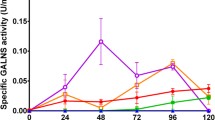Abstract
Dopachrome tautomerase (DCT) plays a critical role in lowering the oxidative stress resulting from melanogenesis. Levels of DCT are elevated in melanoma cell lines that are especially resistant to chemotherapy and radiation. DCT is processed as a melanoma antigen and is a potential target for immunotherapy. In order to establish a more complete understanding of the role that DCT may play in the etiology and treatment of melanoma skin cancer, isolation of highly pure and properly processed protein is necessary. Purification of native DCT has been problematic due to a hydrophobic transmembrane anchor and interactions with melanin. In this study, DCT was expressed, without its carboxy-terminal transmembrane region using an Sf9 insect cell protein expression system and its recombinant protein was purified by various chromatographic techniques. Analysis of DCT tryptic peptides by MALDI-TOF/TOF determined N-glycosylation as a primary post-translational modification. Our success in the expression of soluble mammalian DCT and the characterization of N-glycosylation sites is a useful reference toward the comprehensive understanding of the structure/function relationship of mammalian DCT.






Similar content being viewed by others
Abbreviations
- DCT:
-
Dopachrome tautomerase
- MALDI-TOF/TOF:
-
Matrix-assisted laser desorption/ionization mass spectrometry with tandem time of flight detection
- TRP-2:
-
Tyrosinase-related protein 2 (an alternative name for DCT)
- ER:
-
Endoplasmic reticulum
- PMSF:
-
Phenylmethylsulphonyl fluoride
- SDS–PAGE:
-
Sodium dodecyl sulfate polyacrylamide gel electrophoresis
- DTT:
-
Dithiothreitol
- TFA:
-
Trifluoroacetic acid
- PNGase F:
-
Peptide N-glycosidase F
- Ni–NTA:
-
Nickel-nitrilotriacetic acid
- CID:
-
Collision induced dissociation
- MS:
-
Mass spectrometry
- Da:
-
Dalton
- CAM:
-
Carboxyamidomethyl
References
Altmann F, Staudacher E, Wilson IB, Marz L (1999) Glycoconj J 16:109–123
Aroca P, Garcia-Borron JC, Solano F, Lozano JA (1990) Biochim Biophys Acta 1035:266–275
Aroca P, Solano F, Garcia-Borron JC, Lozano JA (1990) J Biochem Biophys Methods 21:35–46
Chi A, Valencia JC, Hu ZZ, Watabe H, Yamaguchi H, Mangini NJ, Huang H, Canfield VA, Cheng KC, Yang F, Abe R, Yamagishi S, Shabanowitz J, Hearing VJ, Wu C, Appella E, Hunt DF (2006) J Proteome Res 5:3135–3144
Chu W, Pak BJ, Bani MR, Kapoor M, Lu SJ, Tamir A, Kerbel RS, Ben-David Y (2000) Oncogene 19:395–402
Gupta G, Sinha S, Mitra N, Surolia A (2008) Glycoconj J
Irungu J, Go EP, Zhang Y, Dalpathado DS, Liao HX, Haynes BF, Desaire H (2008) J Am Soc Mass Spectrom 19:1209–1220
James DC, Freedman RB, Hoare M, Ogonah OW, Rooney BC, Larionov OA, Dobrovolsky VN, Lagutin OV, Jenkins N (1995) Biotechnology (N Y) 13:592–596
Khoshnoodi J, Hill S, Tryggvason K, Hudson B, Friedman DB (2007) J Mass Spectrom 42:370–379
Li JS, Vavricka CJ, Christensen BM, Li J (2007) Proteomics 7:2557–2569
Loo T, Patchett ML, Norris GE, Lott JS (2002) Protein Expr Purif 24:90–98
Lopez M, Coddeville B, Langridge J, Plancke Y, Sautiere P, Chaabihi H, Chirat F, Harduin-Lepers A, Cerutti M, Verbert A, Delannoy P (1997) Glycobiology 7:635–651
Lu X, Jiang X, Liu R, Zhao H, Liang Z (2008) Cancer Lett 271:129–139
Negroiu G, Dwek RA, Petrescu SM (2003) The Journal of biological chemistry 278:27035–27042
Ostankovitch M, Altrich-Vanlith M, Robila V, Engelhard VH (2009) J Immunol 182:4830–4835
Pak BJ, Lee J, Thai BL, Fuchs SY, Shaked Y, Ronai Z, Kerbel RS, Ben-David Y (2004) Oncogene 23:30–38
Pak BJ, Li Q, Kerbel RS, Ben-David Y (2000) Melanoma Res 10:499–505
Pawelek JM, Lerner AB (1978) Nature 276:626–628
Tomiya N, Narang S, Lee YC, Betenbaugh MJ (2004) Glycoconj J 21:343–360
Toyofuku K, Wada I, Valencia JC, Kushimoto T, Ferrans VJ, Hearing VJ (2001) Faseb J 15:2149–2161
Tsukamoto K, Jackson IJ, Urabe K, Montague PM, Hearing VJ (1992) EMBO J 11:519–526
Umansky V, Abschuetz O, Osen W, Ramacher M, Zhao F, Kato M, Schadendorf D (2008) Cancer Res 68:9451–9458
Wang N, Daniels R, Hebert DN (2005) Mol Biol Cell 16:3740–3752
Wang RF, Appella E, Kawakami Y, Kang X, Rosenberg SA (1996) The Journal of experimental medicine 184:2207–2216
Yeh JC, Seals JR, Murphy CI, van Halbeek H, Cummings RD (1993) Biochemistry 32:11087–11099
Acknowledgments
We would like to express our thanks to Dr. Vincent Hearing for generously providing us with DCT antibodies and Dr. Dorothy Bennett for providing us with melan-a -b and -c cell lines that were used in our preliminary studies. We would also like to thank Peipei Liu and Chuansheng Liu at The Chinese Academy of Sciences Key Laboratory of Pathogenic Microbiology and Immunology for their encouragement and comments on the manuscript. Furthermore, we would like to thank Dr. Rich Helm and the Virginia Tech Mass Spectrometry Incubator (http://www.mass.biochem.vt.edu/) for their assistance with the MALDI-TOF/TOF analysis. This work is supported by College of Agricultural Life Sciences, Virginia Tech and NIH grant AI 19769.
Author information
Authors and Affiliations
Corresponding author
Electronic supplementary material
Below is the link to the electronic supplementary material.
10930_2010_9241_MOESM1_ESM.docx
MALDI-TOF/TOF spectrum of the DCT peptide NECDVCTDELLGAAR, A) with potential fucosylation (additional 146 Da), and B) without modification
Rights and permissions
About this article
Cite this article
Vavricka, C.J., Ray, K.W., Christensen, B.M. et al. Purification and N-Glycosylation Analysis of Melanoma Antigen Dopachrome Tautomerase. Protein J 29, 204–212 (2010). https://doi.org/10.1007/s10930-010-9241-9
Published:
Issue Date:
DOI: https://doi.org/10.1007/s10930-010-9241-9




